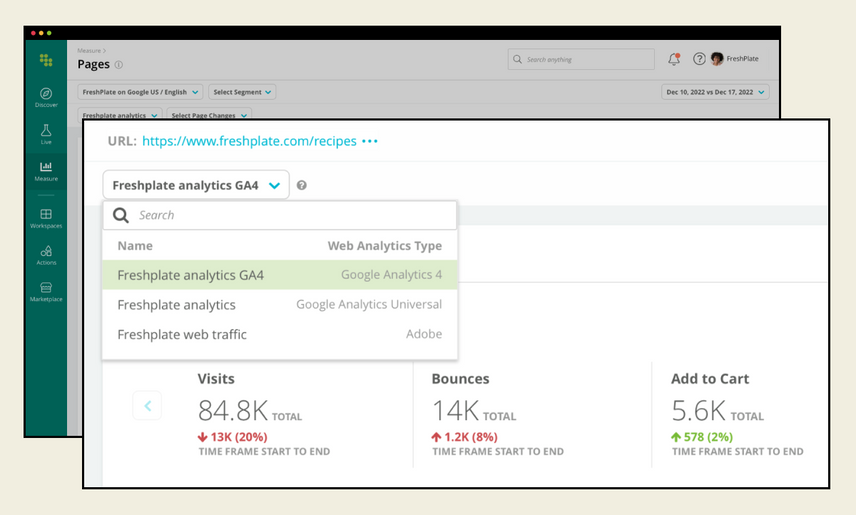Access the Future of SEO Analytics with Google Analytics 4
- Product News
- By multiple authors
- 8 minutes read
Tap into the next evolution of digital analytics with Conductor’s GA4 integration. Get a holistic view of your SEO impact with event-based, multi-device tracking.
In today's increasingly digital world, customer behavior and preferences are constantly evolving. To stay ahead of the curve, companies must have accurate and comprehensive insights into their digital performance. It also means the way data is collected and tracked needs to evolve and adapt accordingly, which is why Google is shaking up the way businesses measure their online presence with its introduction of Google Analytics 4 (GA4).
Unlike Universal Analytics (UA), which primarily focuses on website data, GA4 provides more holistic insights into user behavior and interactions across multiple devices and platforms, such as mobile apps and smart devices. This enables businesses to take a more accurate, user-centric view of the customer journey, leading to better optimization of their website and content—in other words, bringing better insights to take your SEO strategy to the next level.
Conductor now supports and makes integrating GA4 data into your organic measurement and reporting processes easy. Read on to gain a better understanding of GA4’s advantages with SEO in mind, including best practices and metrics you can put into place when first configuring your GA4 property, migration hacks, and some powerful SEO use cases that GA4 now helps unlock.
GA4 for SEO: How to set up and take advantage of better audience insights and digital presence tracking
Most digital marketers are looking to answer two critical questions through their analytics: How do people get to my website and what do they do once they get there? Or put a little differently with SEO as the primary focus: How does my content get found and does it drive value and engagement?
The most significant shift in GA4 is its user-centric approach to tracking and analysis. By using event-based tracking, it looks at the full user experience rather than segmented user experiences by each individual device or medium. In UA, any interaction is recorded with a Category, Action, and Label and is its own hit type, which includes page hits, event hits, eCommerce hits, and social interaction hits. In contrast, Google Analytics 4 data is event-based, where any interaction is captured as an event.
Universal Analytics | Google Analytics 4 |
|---|---|
Page View Hit | Event |
Event Hit | Event |
Social Hit | Event |
Transaction/eCommerce Hit | Event |
User Timing Hit | Event |
Exception Hit | Event |
App/Screen View Hit | Event |
Table Source: Google Support Resource for Universal Analytics versus Google Analytics 4 data
This enables far greater data flexibility and empowers marketers by making it easier to create and customize events. The ability to combine multiple events also opens up a lot of exciting opportunities in terms of tracking conversions and building reports. Event-based tracking is also better adapted for cookieless measurement and privacy concerns (e.g., GDPR). Then once set up, this improved data can be pulled into Conductor to seamlessly measure organic performance and impact on user behavior and business outcomes.

Creating events
The added flexibility around event creation means more relevant and specific SEO performance reporting in Conductor. Take the opportunity to think about what metrics are the best indicators of success in your organic strategy, and ensure they are properly set up for easy integration.
GA4 automatically collects certain events data out of the box without the need for Google Tag Manager (GTM) or custom tracking. However, there may be events you wish to track that are not captured natively in GA4. In that case, you also have the option to set up enhanced measurements events , recommended events , and custom events . For instance, we often see our own Conductor customers create recommended events, such as “login” and “add_to_cart,” and custom events for different use cases, such as form fills and non-YouTube video embeds.
Helpful tips for tracking setup
- Start by auditing what your GA4 account is already tracking. This way you will know what data your website is currently set up to send to GA4 and what else you may need to set up.
- Understand what parameters you would like to collect that will help you tell the story of your users. It can be a dimension, a metric, a custom value, or a specific action (e.g., location, browser, sessions, etc.).
- Think about what audiences and segments you would like to build. What information will help you categorize your visitors based on their activity?
- It’s also helpful to work backward to understand what events you should be tracking. Follow your user journeys from top-of-funnel to conversion and consider the events that are necessary to capture this data.
- Consider event tracking limitations and competing priorities across your organization when finalizing the list of custom events to collect.
Don’t forget to check your GA4 settings
In addition to defining what events to capture, there are a few settings within GA4 that are important to be aware of.
For Google Analytics 4 properties (non-Analytics 360 version), retention of user-level data, including conversions, and other event data is set to 2 months by default. You can extend this to a maximum of 14 months, and should do so as soon as you set up your GA4 property, as this is not retroactive for previously accumulated data. As an added plus, data retention within Conductor is much longer than 14 months, which can be a helpful backup for the data you have integrated.
You should also ensure that you’re getting cross-device reporting for signed-in Google users by turning on Google Signals. But be sure to always review your local data privacy and security protocols before turning this on. Verify you have the required disclosures for collecting this data.
Conductor GA4 integration: Migration hacks and support
UA’s July 1 sunset date will be here before you know it. After this date, new data will only flow into GA4 properties, making it crucial to migrate to GA4 as early as possible to stay up-to-date and avoid data loss. But the fundamental data model differences that enable GA4’s significant advantages can also make migrating from your existing UA setup complicated. Rather than a simple copy-paste of previous event logic, you may have to start from zero in some cases—making transitioning to GA4 as the new measurement standard a daunting task for many marketers.
But having your Google Analytics data integrated with Conductor means you don’t have to say goodbye to your historical UA data. While Google is only making your UA data accessible until the end of the year, Conductor stores all of your historical performance data previously ingested in the platform—without a time limit. Keep access to key context on how past campaigns and releases have impacted channel results whenever you need it in Conductor.
And because Conductor gives you access to GA4 and UA metrics simultaneously for the same reports, you can leverage this ability to make the transition at your own pace. If you don’t yet feel confident using GA4 as your primary analytics source with all the new changes you’re still figuring out, you’re not alone. Conductor supports multiple analytics integrations for any domain and rank source, making it possible to compare UA and GA4 metrics to build a better interpretation of data and make informed adjustments to future reporting. Our platform gives customers the security of being able to maintain a reliable, familiar process while having the confidence to start testing and taking advantage of GA's improved insights before July 1.

Unlock GA4’s potential in Conductor
The importance of accurately defining and setting up the data points you should be collecting is ultimately to give you the ability to interpret whether your actions are effectively driving results. GA4 unlocks more powerful segmentation abilities to add better context around your organic performance and tell the story of how your audience finds and engages with your content.
You can now create segments based on users, sessions, and events. GA4 provides a few suggested segments within its platform to help get you started, but you can easily modify the templates to fit your specifications or create custom segments. Build segments for your organic traffic, backlink referral traffic, conversions, and more, to cross-reference with your performance in Conductor. Ask important questions, such as:
- Is my organic traffic converting at the same rate as visitors from other channels?
- What’s driving new organic traffic after ranking for a new set of keywords?
- How are visitors engaging with your content? (Tip: create scroll depth events to understand how much of your content visitors are engaging with—90%? 50%? 25%?)
- Are you optimized to rank for the right keywords?
- Are highly engaged visitors converting at the same rate as less engaged visitors?
Map your segments in GA4 to your content performance reports in Conductor and use them to add additional context around your ranking performance. Assess traffic drops, review top traffic driving keywords and check for the technical health of your pages. Leveraging the new capabilities of GA4 in Conductor and ContentKing will allow you to better understand the effectiveness of your SEO campaigns and inform future wins.
The next evolution of digital analytics meets the SEO platform of the future
GA4 is transforming the way businesses measure their online presence. Its advanced features, improved measurement capabilities, and better control over data privacy make it easier to track and optimize your digital content to improve SEO performance.
Conductor enables customers to store and access historical analytics data and simultaneously collect data across both UA and GA4 properties to support a smoother transition toward a more comprehensive and accurate understanding of holistic digital performance. We’re excited to welcome the future of analytics into our platform and help businesses stay ahead of the curve.








